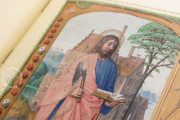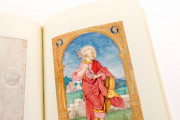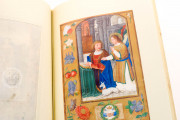The so-called Prayer Book of Johann Albrecht I, Duke of Mecklenburg, is an album of paintings on parchment, most from book projects and some more probably always intended as independent works of art. The volume unites paintings dating from the 1510s to ca. 1530 made in Bruges and Nuremberg. All the paintings probably came from the collection of Cardinal Albrecht of Brandenburg (1490-1545), Archbishop and Elector of Mainz, one of the great art patrons of the sixteenth century.
Although mounted on paper hinges and bound together by the duke, the paintings, all of which have painted borders or frames, vary in size (from 16.7 to 23.9 cm in height). The artists represented among the thirty-five full-page and nine three-quarter-page miniatures are Simon Bening and his workshop, Nikolaus Glockendon, Sebald Beham, Albrecht Glockendon, and an unidentified Nuremberg painter.
Most of the paintings depict Christian saints and biblical scenes, but representations of the celebration of Mass (Kassel, fol. 31r), the Rape of Lucretia from ancient Roman mythohistory (Kassel, fol. 40r), and Pyramus and Thisbe from Ovid's Metamorphoses (Kassel, fol. 41r) are also included. Four paintings are elaborate coats of arms.
Miniatures from a Book of Hours
Twenty-five of the paintings were made for a book of hours principally illuminated by Simon Bening and his workshop in Bruges (Stockholm, Kungliga Biblioteket, Cod. Holm. A 227), apparently dismantled early in its history. That book was made for Melchior Pfinzing (1481-1535), who was secretary to Holy Roman Emperor Maximilian I and provost at the church of Saint Sebald in Nuremberg.
Fifteen of Bening's paintings are full-page miniatures, blank on the back, that were originally versos introducing major sections of the book's text. Another nine are three-quarter-page miniatures on original rectos introducing short prayers to saints that continue onto the versos of the leaves. Most of Bening's miniatures have strewn-flower borders or fictive carved wood frames. Pfinzing's full-page coat of arms (Kassel, fol. 15r) for this manuscript was painted by an unidentified Nuremberg artist and added to the codex after it arrived in the city.
Miniatures from a Variety of Sources
The origins of the paintings by the brothers Nikolaus and Albrecht Glockendon and Sebald Beham, all active in Nuremberg, are less clear. Although most are thought to have been destined for manuscript prayer books, they may never have been incorporated. Nikolaus Glockendon's Annunciation to the Shepherds (Kassel, fol, 23r) was certainly intended for a manuscript made for Albrecht of Brandenburg (Aschaffenburg, Hofbibliothek, MS 9).
Several more of Nikolaus's paintings and the three signed by Sebald Beham were probably also destined for manuscripts made for the cardinal, whereas Albrecht Glockendon's rendering of the Virgin and Child on a Crescent Moon (Kassel, fol. 38r) most probably was always intended to be an independent painting.
Bound in Pigskin
The white pigskin binding connects this manuscript to the owner after whom it is named: Duke Johann Albrecht. Its gilt-tooled decoration includes his initials and the date 1569. The front and back covers are embellished with panel stamped images of the resurrected Christ and Adam and Eve, respectively, each surrounded by gilt-tooled foliate motifs.
A Tumultuous History
The paintings probably came into the duke's possession by way of his mother, Albrecht of Brandenburg's sister, Anna. The album came into the court library of Moritz the Wise (1572-1632), Landgrave of Hesse-Kassel, from the estate of his daughter, Elizabeth of Hesse-Kassel (1596-1625), Duchess of Mecklenburg, who had received it as a gift from her husband, the album-maker's son Johann Albrecht II of Mecklenburg (1590-1636). The court library of the margraves became the Landesbibliothek Kassel in 1831, which was subsumed into the Gesamthochschulbibliothek in 1976.
The Brothers Grimm of fairy tale fame examined the manuscript in 1817, observing that one leaf, almost certainly the one now in a private collection, was missing from an original forty-four. In 1840, most of the leaves were removed from the album and framed, their original order lost to posterity. Seven of the framed miniatures were stolen by an American soldier, William Braemer, in the aftermath of World War II. Later in the possession of Thomas Chatalbash, the leaves were returned to the Gesamthochschulbibliothek (now Universitätsbibliothek) in 1998.
We have 1 facsimile edition of the manuscript "Prayer Book of Johann Albrecht I, Duke of Mecklenburg": Gebetbuch des Herzogs Johann Albrecht von Mecklenburg facsimile edition, published by Coron Verlag, 2006
Request Info / Price

































